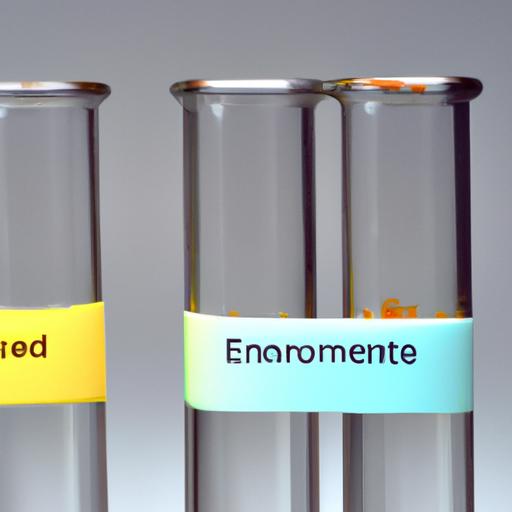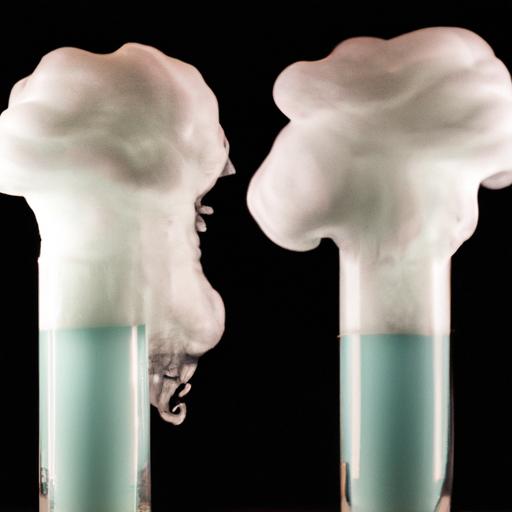
Curious about elephant toothpaste? Discover if this chemical reaction is endothermic or exothermic. Uncover the science behind the foamy eruption!
Introduction
Have you ever heard of elephant toothpaste? It’s not your typical toothpaste found in your bathroom cabinet. Elephant toothpaste is a fascinating chemical reaction that creates an impressive foamy eruption resembling a giant-sized toothpaste tube for elephants. But have you ever wondered whether this reaction is endothermic or exothermic? In this article, we’ll delve into the world of chemical reactions, explore the endothermic and exothermic nature, and determine which category elephant toothpaste falls into.

Two test tubes representing endothermic and exothermic reactions.
Understanding Endothermic and Exothermic Reactions
Before we dive into the specifics of elephant toothpaste, let’s first understand the concepts of endothermic and exothermic reactions. Chemical reactions can be classified based on the heat exchange that occurs during the process.
Endothermic reactions are those that absorb heat from the surroundings, resulting in a decrease in temperature. In these reactions, energy is taken in, causing the reaction mixture to feel colder. An example of an endothermic reaction is the process of ice melting. As ice absorbs heat from its surroundings, it transforms into liquid water, causing the temperature to drop.
On the other hand, exothermic reactions release heat into the surroundings, leading to a temperature increase. These reactions are characterized by the release of energy, often in the form of heat or light. Combustion reactions, such as burning wood, are classic examples of exothermic reactions, as they generate heat and light.
It’s important to note that endothermic and exothermic reactions are fundamentally different in terms of the heat exchange occurring during the reaction process. Now, let’s explore how elephant toothpaste fits into this framework.

Impressive eruption of elephant toothpaste during the experiment.
Elephant Toothpaste Experiment
The elephant toothpaste experiment is a popular and visually captivating demonstration of a chemical reaction. It involves the rapid decomposition of hydrogen peroxide using a catalyst, typically potassium iodide or yeast, resulting in the release of oxygen gas and the formation of a foamy eruption.
To conduct this experiment, gather the following materials: a 30% hydrogen peroxide solution, liquid dish soap, food coloring (optional), a container, and a catalyst (potassium iodide or yeast). Here’s a step-by-step procedure:
- Pour the hydrogen peroxide solution into the container.
- Add a few drops of liquid dish soap to the hydrogen peroxide.
- If desired, add a few drops of food coloring to create a visually appealing effect.
- Finally, add the catalyst (potassium iodide or yeast) to initiate the reaction.
As soon as the catalyst is added, the chemical reaction begins, resulting in a rapid release of oxygen gas. This gas gets trapped in the soap bubbles, causing the foam to expand and create the magnificent eruption resembling elephant toothpaste.

Foam formation and gas release in elephant toothpaste experiment.
Determining if Elephant Toothpaste is Endothermic or Exothermic
Now that we’ve explored the elephant toothpaste experiment, let’s analyze the heat exchange to determine whether this reaction is endothermic or exothermic.
During the elephant toothpaste reaction, we observe a significant release of gas and the formation of foam. This release of gas is indicative of an exothermic reaction, as the reaction releases energy in the form of gas expansion. Additionally, the foam formation is a visual representation of the heat released during the reaction.
The foamy eruption in elephant toothpaste is caused by the rapid expansion of oxygen gas, which is released as a byproduct. This expansion and foam formation suggest that the reaction is exothermic, releasing energy in the form of heat and gas production.
By comparing the characteristics of elephant toothpaste with those of exothermic reactions, we can confidently conclude that elephant toothpaste is indeed an exothermic reaction.
Conclusion
In conclusion, the elephant toothpaste experiment provides an exciting opportunity to witness a visually captivating chemical reaction. By combining hydrogen peroxide, a catalyst, and soap, we observe a rapid release of oxygen gas, resulting in a foamy eruption. Based on the characteristics and observations of the reaction, it is evident that elephant toothpaste is an exothermic reaction.
Understanding the endothermic and exothermic nature of reactions is crucial in various fields, from understanding everyday chemical processes to studying the complexities of thermodynamics. So, the next time you conduct the elephant toothpaste experiment, remember that you’re witnessing an exothermic reaction that captivates both young and old with its impressive foamy display.
If you’re interested in learning more about dental hygiene and toothpaste, check out BestWaterFlosserHQ for valuable information. Happy experimenting and keep exploring the wonders of chemistry!







